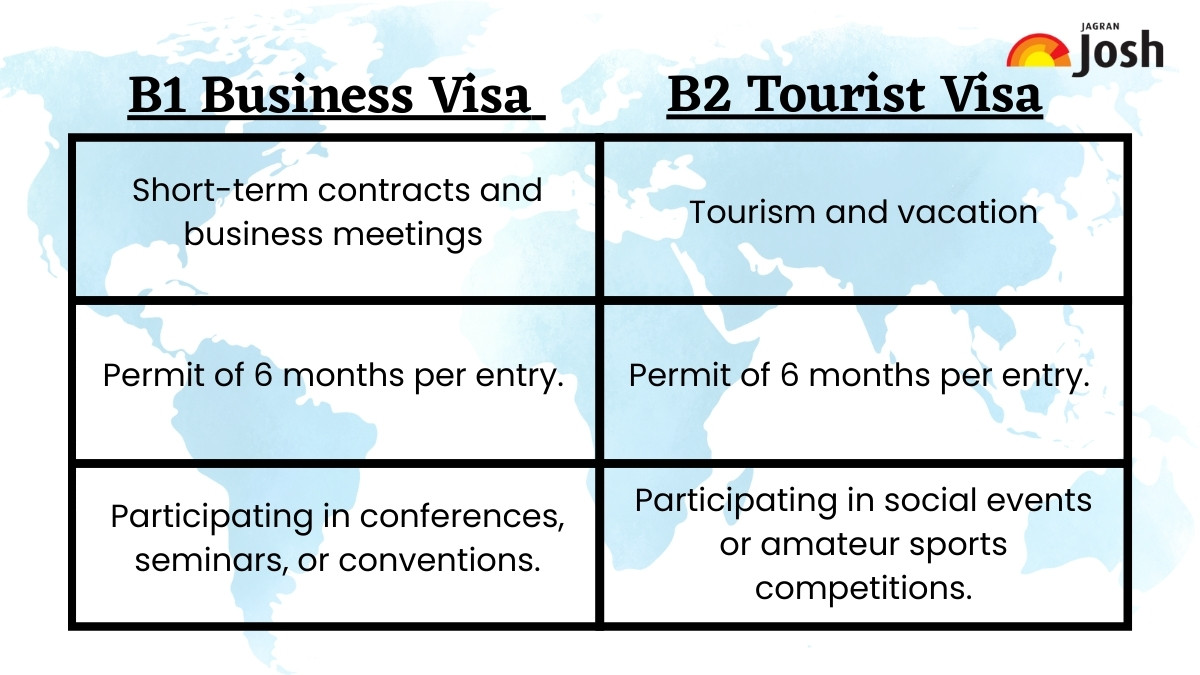B1 visa vs B2 visa: The US Department of State's recent report shows that there has been a big increase in applications for visitor visas. This shows how important it is to know the different types of visas. Understanding the differences between the B1 and B2 visas is the first important step for anyone who wants to visit the United States for a short time. While many people believe these are interchangeable, they are issued for very distinct purposes. The difference is very important for both the applicant and their host, because a mistake could cause problems at the port of entry or even get the visa denied. With millions of new applicants, knowing the specific rules for a US tourist visa versus a US business visa is more vital than ever.
What is the Difference Between a B1 and a B2 Visa?
This table clearly shows the differences between the B1 and B2 visas. This is great for quickly finding what you need and comparing things.

| Feature | B1 Visa (Business) | B2 Visa (Tourism) |
| Primary Purpose | Short-term business activities | Tourism, pleasure, or medical treatment |
| Examples of Activities | Going to conferences, negotiating contracts, talking to business partners, settling an estate, or taking professional exams. | Going on vacation, visiting friends or family, seeing the sights, getting medical care, or going to social events. |
| Duration of Stay | Typically up to 6 months per entry. The final decision is made by the CBP officer at the port of entry. | Typically up to 6 months per entry. The final decision is made by the CBP officer at the port of entry. |
| Work Authorization | Not allowed to work for a U.S. employer or receive a salary from a U.S. source. | Not allowed to work for a U.S. employer or engage in any type of paid employment. |
| Common Outcome | Often given as a B1/B2 visa, which lets you do both business and tourist things on the same trip. | Often given as a B1/B2 visa so that you can do both business and tourist things on the same trip. |
| Required Documents | An invitation letter from a U.S. company, a business itinerary, and proof that you work in your home country. | If you need one, you should have a travel itinerary, hotel reservations, and a letter of invitation from a U.S. host. |
Difference between B1 and B2 Visa Cost
The cost for the B1 and B2 visas is the same, as both fall under the same non-immigrant visa application category. The current government filing fee is $185, but it's important to be aware of a new $250 visa integrity fee that will apply to many applicants from countries not on the U.S. visa waiver list starting October 2025. This additional fee will raise the total cost of a B1/B2 visa to around $425. This integrity fee is non-refundable and is in addition to other charges.
What are B1 and B2 Visas for?
The main difference between the B1 and B2 visas is why you are traveling. One is for work and the other is for fun.
-
B1 Visa (Business): This visa is for people who are not immigrants and are coming to the U.S. for business reasons that don't involve getting paid by a U.S. source. This includes attending a conference, consulting with business partners, or negotiating contracts. A B1 visa is designed for short-term, professional engagements.
-
B2 Visa (Tourism): This visa is for travel for fun, vacations, and tourism. It's the visa you need to visit friends or family, go sightseeing, attend a concert, or even get medical treatment. The B2 visa is purely for personal reasons.
The most common outcome for a qualifying applicant is the granting of a combined B1/B2 visa. This type of visa lets you do both business and pleasure on the same trip, making it a flexible choice.
Also Read - List of Top 11 First World Countries in 2025 (Updated)
B1 and B2 Visa Allowed Activities: What's the Official List?
The Department of State lists the specific activities that are allowed on a B1 visa and a B2 visa. You should know these activities to make sure you're using the right visa.
B1 Visa Activities
-
Attending professional conferences, conventions, or seminars.
-
Talking to business partners.
-
Going on a trip to settle an estate.
-
Conducting independent research.
-
Negotiating contracts or deals.
B2 Visa Activities
-
Recreational tourism and sightseeing.
-
Visiting family and friends.
-
Taking a short, non-degree course, like a cooking class.
-
Receiving medical treatment.
-
Taking part in an amateur music, sports, or other event.
To avoid any problems or confusion during the interview process or when you arrive at a U.S. port of entry, you need to understand these lists for the B1/B2 visa application.
The B1 and B2 visas are different, but the B1/B2 visa is the most common. The process will go much more smoothly and get you ready for a successful trip to the US if you make sure your application is for the right purpose and that you have all the necessary paperwork.
Check Out: Which are the 9 Safest African Countries in 2025? Check List (Updated)
To see more of such stories, you can go ahead and add this site to your preferred sources by clicking here
Comments
All Comments (0)
Join the conversation